
It’s January 2017, President Trump has taken up official residence in the White House and the lithium market remains White hot. Is there a connection? No. There’s no natural reason to trot out the insatiable lithium demand narrative yet again, is there? Well, no, but I will anyway. 2016 was a remarkable year for natural resource investors, almost everyone had a thrilling ride. Lithium stocks were very strong until July, then cooled off through October. Even coal stocks flourished! Gold & silver had huge runs, but ran out of steam in August. Uranium was a complete dud, until all of a sudden, in November, it wasn’t.

What sectors will be hot in 2017? I have no idea, but if you think Cannabis / Marijuana is the play, then you’re reading the wrong article. This piece is on lithium, where there’s rapidly growing interest in brine projects in Chile. This is a new development in the sector because Chile had been a no-go zone for juniors until about 6-9 months ago. Now it’s a, must-go-make-a-deal-immediately zone, and the stampede is just beginning. First movers like Wealth Minerals (TSX-V: WML) / (OTC: WMLLF), Lithium Power Intl., LiCo Energy and Bearing Resources have a notable head start, but the number of players will likely double or triple before long.
Ok, slow down now, let me catch my breath…. There’s a good reason why Chile hasn’t been overrun by lithium company wannabes, yet…. Like Argentina, Chile is still a place where long-standing relationships, boots on the ground, are not just important, they’re a pre-requisite for doing business. Newcomers to Chile are a year behind Argentina’s bumper crop, but things are moving faster this time. Will the lithium boom outlast Trump’s Presidency?
To find out more, I tapped CEO Henk van Alphen of Wealth Minerals. At the end of the interview, I was fortunate to be able to sneak in questions for Executive Director (Chile), Marcelo Awad and President Tim McCutcheon.

Epstein Research [ER]: Lithium junior management teams with assets across the globe, ALL say they have great, “connections” with the powers that be. How can readers be confident Wealth Minerals’ team truly has strong relationships in Chile?
CEO Alphen: That’s a fair question, a clear distinction between us and other juniors is that myself, Directors Marcelo Awad and Leonard Harris, President Tim McCutcheon and COO/Director Juan Tang have very significant mineral resources experience in South America, (Peru/Chile/Argentina). Management teams retain lawyers, consultants & deal makers, but if key executives have limited or no in-country relationships, that’s a big problem.
I’ve been investing, working and operating in South America for 26 years, South America is my backyard. Marcelo’s reputation speaks for itself, he’s one of the best known and most respected mining executives on the continent. He opens doors for us that other teams don’t know exist. Our COO Juan Tang has an ideal background for Wealth Minerals, he’s a world-class environmental engineer and has tremendous relationships in China, combined with substantial mining experience in Peru, and he’s fluent in Mandarin, Spanish & English.
[ER]: Is the endgame for Wealth Minerals simply to sell the company to the highest bidder later this year or next?
Alphen: We have every intention of advancing each of our projects as far and as fast as we can. Along the way we expect to partner on some or all of our projects. Interest in Chile, in lithium and in our concessions is increasing by the day. We are in talks to lock down additional concessions, but we have nothing definitive to report at this time. While the rush into jurisdictions like Nevada, Quebec/Ontario, even northern Argentina could be about to hit a brick wall, the opposite is true in Chile. We have a very significant first mover advantage.
Recent transactions among newcomers and local companies are sending a clear message. The price of playing poker in Chile has gone way up….. Recently, a junior signed an agreement to earn a 50% interest in an exploitation concession in the Atacama. The price of this poker hand? Cash plus shares in the company worth about US$ 9 M. To earn another 10%, the ante goes up again– another US$ 10 M. This project is considerably more advanced then our green field Atacama project, but it’s smaller. Ultimately, we feel this is good for first movers like us if it means followers get priced out of the market.

[ER]: I think you are referring to LiCo Energy’s announced LOI to acquire up to a 60% Interest in the Purickutal lithium exploitation concession. Are there other comparable transactions of note?
Alphen: Yes, LiCo Energy, an interesting company that also has a cobalt play. Another transaction involved Lithium Power Intl. acquiring a 50% stake in the Maricunga project in the Salar de Maricunga. I believe they’re investing US$ 27 M = C$ 36 M in cash, plus 16 M shares in LPI.ax (worth about C$6 M at issuance), for 50% of the project. That’s ~US$ 14,000/hectare, net to Lithium Power. We’re paying ~US$ 660/hectare on our 46,200 hectare Atacama project. Having said that, the Maricunga project is well more advanced.
[ER]: What are the biggest risks facing the Company?
Alphen: Like most natural resource juniors, we are a highly speculative company, exposed to many significant risks. Obviously, a perceived big risk is our choice to build a lithium portfolio in Chile, but we feel we’ve done our homework and have very experienced people who know what they’re doing, so Chile is a risk that we’ve embraced. If Chile was a no-brainer, we wouldn’t have the opportunity we have today. Funding is the other key challenge we will be working hard on this year.
That’s why we’re in continuous discussions with multiple interested parties on a number of corporate initiatives. We expect to fund operations with a combination of cash payments from farm-out partners and equity capital. So for example, we might sell down our 100% ownership in a project to say, 30% ownership, in exchange for being free-carried for a number of years. Doing that would de-risk Wealth Minerals’s portfolio and it’s something we will start doing as soon as this quarter.
[ER]: Are you looking at additional acquisitions? Or, do you have enough on your plate?
Alphen: We currently have 5 projects about 55,000 hectares. As long as we continue to strike great deals, we will go for it. We don’t see signs of a slowing of interest in lithium brines in Chile. We’re looking for transactions that complement our existing portfolio and increase our head start. Each concession we control is one that a competitor cannot, unless they come to us. This year will also be a lot about exploration and moving our projects forward. Shareholders can look forward to brine sampling, geophysics and most importantly drilling, initially focused on the Atacama.
Atacama is host to the best environment for harvesting lithium brines on the planet. We have both the highest grades and evaporation rates. That means desired lithium concentrations from solar evaporation can be obtained 25% to 50% faster, and that’s why the Atacama has the lowest cost production in the word at around US$ 2,500 – US$ 3,000/ metric tonne.
[ER]: Marcelo, you are a well known and respected mining executive in South America, with 18 years at Codelco and 16 more at Antofagasta Minerals. You could be actively involved in any company or sector… Why did you choose lithium, and why Wealth Minerals?
Mr. Marcelo Awad: That’s true, I have had the chance since I left Antofagasta Minerals to join big Companies, but I decided to build up a portfolio of Boards and Advising Roles. Fortunately that decision went well. With Henk we’ve known each other for years and last year he told me about his plan to acquire Lithium assets in Chile and asked me if would I assist him to do so. I immediately got interested because I knew his ability and reputation as head of Wealth Minerals and also because I was reading about the Lithium market and the big potential Chile had based on the size of its reserves. I told myself with my mining knowledge, this was a good opportunity to help both Chile and Wealth Minerals in the development of the Lithium business, which will certainly help the Chilean economy.
[ER]: Tim, can you describe the differences among global lithium brine operations / proposed projects? How does Wealth Minerals’ Proyecto Atacama project fit in?
Mr. Tim McCutcheon: There are several factors that determine the success of a lithium brine deposit. One is size of the overall salar, each has a balance of water coming in and going out. A challenge for extracting lithium is to ensure extracted brine is replenished. Water is the mechanism that conveys lithium to surface for processing – no water means no lithium. Larger salars have more water coming in, allowing more to go out, without harming a salar’s equilibrium. Smaller salars face physical limits on how much processing capacity can be installed. As the 3rd largest salar in the world, Atacama has tremendous lithium production capacity.
Grade is another critical factor. Larger salars are older, so there’s been more time for lithium to be deposited, which translates to higher grade. SQM’s grade is 2-3 times larger than many other global brine projects. It’s no surprise that lithium brine extraction was pioneered in the Atacama.
A last factor is aridness. There are many technologies, most unproven at commercial scale, to produce lithium from brine extracts, but by far the lowest-risk is open air evaporation. The Atacama salar sits at low altitude compared to most other lithium-bearing salars. And, it’s possibly the direst place on the planet. Therefore, it has the highest evaporation rate, leading to the lowest production cost in the industry.
Disclosures: The content of this article is for informational and illustrative purposes only. Readers fully understand and agree that nothing contained herein, written by Peter Epstein of Epstein Research, [ER] including but not limited to, commentary, opinions, views, assumptions, reported facts, estimates, calculations, etc. is to be considered, in any way whatsoever, implicit or explicit investment advice. Further, nothing contained herein is a recommendation or solicitation to buy or sell any security. The content contained herein is not directed at any individual or group. Mr. Epstein and [ER] are not responsible, under any circumstances whatsoever, for investment actions taken by the reader. Mr. Epstein and [ER] have never been, and are not currently, a registered or licensed financial advisor or broker/dealer, investment advisor, stockbroker, trader, money manager, compliance or legal officer, and they do not perform market making activities. Mr. Epstein and [ER] are not directly employed by any company, group, organization, party or person. Shares of Wealth Minerals are highly speculative, not suitable for all investors. Readers understand and agree that investments in small cap stocks can result in a 100% loss of invested funds. It is assumed and agreed upon by readers that they consult with their own licensed or registered financial advisors before making investment decisions.
At the time this article was posted, Peter Epstein owned shares in Wealth Minerals and the Company was a sponsor of Epstein Research. Readers understand and agree that they must conduct their own research, above and beyond reading this article. While the author believes he’s diligent in screening out companies that are unattractive investment opportunities, he cannot guarantee that his efforts will (or have been) successful. Mr. Epstein & [ER] are not responsible for any perceived, or actual, errors including, but not limited to, commentary, opinions, views, assumptions, reported facts & financial calculations, or for the completeness of this article or future content. Mr. Epstein & [ER] are not expected or required to subsequently follow or cover events & news, or write about any particular company or topic. Mr. Epstein and [ER] are not experts in any company, industry sector or investment topic.

Gold has rebounded sharply higher in the past month, taking the early lead as 2017’s best-performing asset class. Normally such a big gold surge would require heavy gold-futures buying by speculators. But they’ve been missing in action, barely moving any capital into gold yet. Their collective bets on this metal remain very bearish. Since they are such a strong contrarian indicator, that’s a very-bullish omen for gold.
The sole mission of speculation and investment, and thus all the endless research that feeds into it, is to multiply wealth. Traders can’t effectively buy low and sell high unless they understand what drives the prices of their trades. For years now, gold has had two overwhelmingly-dominant drivers. Their capital flows fully explain the vast majority of all gold’s price action, and thus are exceedingly important to study.
The first is the world-leading GLD SPDR Gold Shares gold ETF. This acts as a conduit for the vast pools of American stock-market capital to slosh into and out of physical gold bullion. Differential supply and demand for GLD shares relative to the underlying gold supply and demand is directly shunted into gold itself. GLD’s physical-gold-bar purchases and sales as its holdings grow and shrink greatly impact gold prices.
Nothing has been more important for gold over the past year than the American stock-market capital that flowed into then out of it via GLD. Speculators and investors can’t understand where gold has been or where it’s likely heading without studying and closely watching GLD’s gold-bullion holdings. Last week I wrote a comprehensive essay digging into this crucial GLD-and-gold relationship in depth, check it out.
But American speculators’ gold-futures trading often overpowers American investors’ GLD-share trading in bulling the gold price around over the short term. Futures speculators enjoy an outsized impact on gold prices wildly disproportionate to the capital they wield for a couple key reasons. First, the American gold-futures price is gold’s de-facto world reference price. It is the most-widely-followed and quoted gold read.
So when these traders buy or sell aggressively and thus rapidly force gold materially higher or lower, it has a big psychological impact on everyone else in the gold world. Gold futures are the speculation tail wagging the far-larger investment dog in gold. Investors controlling vastly more capital than gold-futures speculators get bullish or bearish, and change their trading behavior accordingly, based on gold-futures action.
Second, gold-futures traders enjoy a radically-inordinate influence on gold thanks to the extreme leverage inherent in gold futures. While investors buy gold outright or with at most 2x leverage through GLD shares, gold-futures speculators often trade gold with incredible 20x to 25x leverage! That means every dollar of capital bet on gold futures can have 20x to 25x the price impact of another dollar invested normally.
So futures speculators’ collective buying and selling can really distort gold prices over the short term, even though gold investment demand will always ultimately prevail as gold’s primary driver. There’s a critical interplay between GLD capital flows and gold-futures action. Parallel buying or selling on both of these fronts always drives gold higher or lower. Opposing buying and selling tends to offset and cancel out.
Unlike GLD-holdings data which is available daily, speculators’ collective gold-futures trading activity is only published at a fuzzier weekly resolution. Late every Friday afternoon the CFTC releases its famous Commitments of Traders reports. These reveal what both hedgers and speculators have been doing in gold futures current to the preceding Tuesday. Watching them is essential to gaming gold price action.
This first chart looks at the aggregate gold-futures long and short positions held by both large and small speculators, in contracts. Each gold-futures contract controls 100 troy ounces of this metal. Total longs or upside bets on gold are rendered in green, while total shorts or downside bets are shown in red. The yellow line shows the deviation of both these bets from normal years’ average levels between 2009 to 2012.
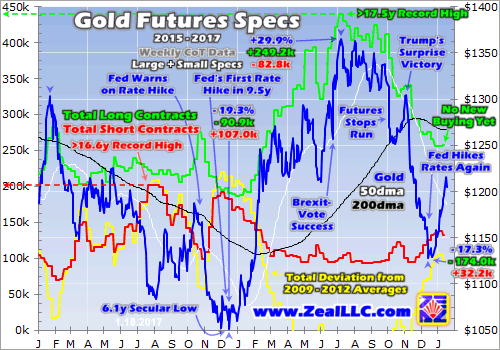
Speculators’ gold-futures data may look complex, but it’s not difficult to understand. Gold’s price over the past couple years or so is superimposed in blue. Gold is strongly positively correlated to speculators’ total gold-futures longs. Every significant gold rally in recent years was partially driven by big gold-futures buying as evidenced by spec longs surging. Until this past month’s rally, which we will get to.
Speculators’ collective upside bets on gold are also a powerful contrarian indicator. Spec longs were high every time gold peaked in the last couple years, including this past summer. As I warned back in mid-July just after gold hit $1365, it faced a record gold-futures selling overhang due to specs’ excessive longs. These hyper-leveraged traders were far too bullish, all-in on gold, implying they would soon have to sell.
The higher spec longs, the more bullish on gold these traders are. But that means they have already deployed most of their available capital, with limited firepower to push gold still higher once they’re all crowded in. So gold rallies often peter out and then reverse once spec longs get excessive. The worst time to get excited about gold is when futures speculators are, since they are the most bullish when gold is topping.
Conversely low spec longs show when these traders are bearish. They don’t expect much upside from gold so they’ve liquidated large fractions of their leveraged long bets. That signals most of the gold-futures selling has already happened, so gold is actually bottoming. Spec longs were really low back in December 2015 when gold was carving a major 6.1-year secular low. That birthed last year’s strong new bull!
So the smart way to game gold’s probable near-term price action is to do the opposite of what the futures speculators as a herd are doing. If they are betting big on higher gold prices as shown by excessive longs, expect an imminent correction. If they are convinced gold is heading lower as seen in low longs, expect a major rally to soon erupt. Fading the futures-speculator mob is the surest way to win in gold trading!
Speculators’ collective gold-futures short positions work similarly, but in the other direction of course. In futures, traders can sell even if they don’t own any contracts to sell. They effectively borrow them from someone else, and then sell them. These debts must soon be repaid, so speculators hope they can buy back the futures contracts at lower prices to return them. They then pocket any difference as profits.
In terms of gold-price impact, there is zero difference between a speculator selling long contracts they already own or short selling ones they don’t. A sale is a sale, they are functionally identical. But since speculators collectively hold fewer gold-futures shorts than longs, shorting has a proportionally-smaller effect on prevailing gold prices. But once again speculators bet wrong as a herd when gold is ready to reverse.
Gold’s major secular lows in 2015 were accompanied by record-high spec short positions! Right when gold was bottoming ahead of major rallies, these guys were holding the largest downside bets. Then as gold subsequently topped, spec shorts had been bought and covered back down to low levels. So gold is most bullish over the near term when speculators are the most bearish as evidenced by excessive shorts.
Futures speculators are always wrong at extremes, when gold has either rallied or corrected too far for too long. High spec longs and low spec shorts are a key warning sign of a major selloff looming, just as I warned last summer. But low spec longs and high spec shorts signal the opposite, that gold is on the verge of embarking on a major new rally. This latter very-bullish situation is exactly what gold is seeing today!
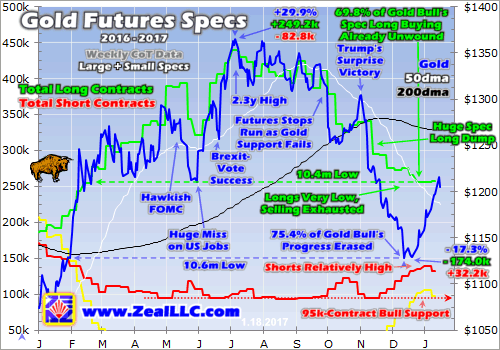
This chart zooms in to the past year or so, but let’s start on Election Day. That night as Trump pulled into a surprise lead in the biggest battleground state of Florida, gold futures rocketed 4.8% higher to $1337! A Trump win was universally assumed to be bad for stock markets and thus good for gold, which is the anti-stock trade since it tends to move counter to stock markets. As stocks rebounded, gold was sold hard.
This heavy post-election gold selling was universal, coming from both investors jettisoning GLD shares and speculators dumping gold futures. With capital rushing out of gold’s two primary drivers, it was just hammered. In the 5 weeks between Election Day and the day after the Fed’s second rate hike in 10.5 years in mid-December, gold plunged 11.5%! That was part of a larger 17.3% major correction since early July’s peak.
Gold’s two biggest plunges in its miserable Q4’16, one of its worst quarters ever, were fueled by heavy gold-futures selling by speculators. Since such extreme leverage exists in this market, traders have to set tight stop losses. If they are running 20x leverage, a mere 5% adverse move in gold against their bets would wipe out 100% of their capital risked! So even minor 1%ish gold moves are major for futures traders.
In early October as gold drifted towards $1300, it triggered a big mass of futures stop losses set near that key psychological support. The resulting mass stopping quickly cascaded, as the more gold futures fell the more stops were tripped unleashing even more selling. Another mass stopping happened just two days after the election when another key gold support zone at its 200-day moving average failed to hold.
These extreme early-October and mid-November episodes of gold-futures selling perfectly illustrate how disproportionate its impact can be. Speculators dumped 43.4k and 45.6k contracts respectively in those two key CoT weeks, unleashing the equivalents of 134.8 and 141.9 metric tons of gold. That is far too much selling for the gold market to absorb in such short spans of time, which cratered the gold price.
For perspective, consider the latest global gold fundamental data available from the World Gold Council current to Q3’16. That 9-month year-to-date span saw massive gold-investment demand, huge by recent years’ standards. Yet it still only averaged 35.6t per week. So whenever gold-futures speculators get spooked or forced into dumping 100t+ in single-week spans, gold is certainly going to get kicked in the teeth.
The resulting sharp drops really crush gold psychology, leaving investors and speculators alike much more bearish and pessimistic. They start to extrapolate that trend, expecting gold to keep falling farther. So they buy less or sell more, and gold’s futures-driven selloff soon becomes self-feeding. It is amazing how much gold futures impact overall gold sentiment, these speculators’ influence is wildly disproportional.
That extreme post-election selling initiated by speculators’ gold-futures stops being run finally ran its course by the day after the Fed hiked rates again last month. Futures speculators have long feared Fed rate hikes’ impact on gold, which is supremely irrational. During the exact spans of all 11 previous Fed-rate-hike cycles since 1971, gold rallied an average of 26.9% higher! They have proven very bullish for gold.
By the time gold finally bottomed last month, its correction had ballooned to 17.3%. That is huge, but still shy of 20%+ new bear territory. In addition to heavy differential GLD-share selling, the other primary driver was heavy gold-futures selling by the speculators. Over that entire correction span since early July, they had liquidated an astounding 174.0k long contracts while adding 32.2k short ones, serious selling.
That equates to 641.3 tonnes of gold, or nearly half of the 1389.2t of global gold investment demand in the first 9 months of 2016! Speculators had unwound fully 69.8% of all the long positions they had added to help drive gold’s new 29.9% bull market between mid-December 2015 and early July. All this extreme selling along with GLD’s blasted gold so low that it erased a staggering 75.4% of its bull’s progress.
With speculators fleeing gold futures at a magnitude that defies belief, they had to be exhausting their selling as I wrote in mid-December. These traders only have so many contracts they can sell, so the more they’ve sold the less selling is still to come. And soon after gold’s 10.6-month low in mid-December, these gold-futures spec long positions had collapsed back down to 255.7k contracts. That was a 10.4-month low.
American speculators hadn’t held fewer gold-futures longs since way back in mid-February before gold had even entered new-bull-market territory yet at a 20%+ gain. So with the great majority of the entire young bull market’s gold-futures long buying already unwound, spec longs are very low today. That is a super-bullish omen just like it was at past major gold lows. These traders have vast firepower to buy back in!
A week after that recent longs low, spec shorts surged to 138.6k contracts. That was also the highest level seen since early February, and way above last year’s 95k-contract support line. While there was some modest covering in the latest CoT report available before this essay was published, shorts are still relatively high. That means speculators have to buy lots of gold futures to cover and offset their shorts.
With speculators very bearish on gold today as evidenced by low longs and high shorts, you couldn’t ask for a more-bullish gold setup. Just as in the past, gold tends to bottom right as these influential traders are reaching selling exhaustion. That leaves nothing but buyers, so gold soon starts rallying in major new uplegs. Indeed one has already begun, despite futures speculators not doing any significant buying yet.
Major gold uplegs are usually born when speculators buy gold futures to cover their short positions. As they are legally obligated to pay back those borrowed contracts, and have to buy to protect their capital when gold rallies, short covering is involuntary. Speculators do it regardless of how they feel about the gold outlook. But that very short covering drives gold higher and starts to erode bearish bottoming psychology.
So the much-larger contingent of gold-futures speculators on the long side soon start buying as gold’s short-covering-fueled rally convinces them it is reversing higher. That starts to turn sentiment bullish again, with buying begetting buying. Eventually that long-side buying drives gold high enough for long enough to get investors, with their vastly-larger pools of capital, interested in starting to buy gold again.
While we saw modest spec short covering of 6.4k contracts as of January 10th, the last CoT data before this essay was published, there has been no material long buying yet. Since that 255.7k-contract trough of spec longs a couple CoT weeks ago, speculators have only added 2.4k contracts. That’s practically a rounding error. Seeing gold blast 7.7% higher in just a month with no real gold-futures buying is remarkable!
And there hasn’t been any differential GLD-share buying either. Gold’s initial rebound out of its deep post-election lows apparently came from Asia. There have been plenty of days in recent weeks where gold rallied significantly overnight when American traders were sleeping. That global gold demand that is pushing up prices without any help from gold’s dominant couple drivers is going to ignite big buying.
Sooner or later gold will have rallied enough to convince both American gold-ETF investors and gold-futures speculators to return. And with specs’ longs so low and shorts so high, they are going to buy with a vengeance to mean revert their excessively-bearish bets back up to more-normal levels. In addition to higher gold prices, there are a couple more key catalysts that will soon spark big gold-futures buying.
Gold-futures traders are highly sensitive to the US dollar, since gold is ultimately the universal world currency. So as today’s wildly-overcrowded long-US-dollar trade inevitably reverses, speculators are going to flood back into gold futures. They will also aggressively buy when the overvalued US stock markets sell off and roll over into their long-overdue bear market, which will lower perceived Fed-rate-hike odds.
With speculators way too bearish today as their low longs and high shorts prove, there’s heavy gold-futures buying coming. It will catapult gold sharply higher in the coming months, as always happens soon after these guys as a herd get too pessimistic. Some combination of higher gold prices, a lower US dollar and/or stock markets, and less-hawkish Fedspeak is going to soon kindle serious gold-futures capital inflows.
This coming major new upleg in this young gold bull can certainly be played with GLD or call options on it. But the gains in the gold miners’ stocks will dwarf the gains in gold, since their profits growth greatly leverages gold’s upside. As I discussed in depth a couple weeks ago, we’re already seeing that. Over that recent single-month span where gold rallied 7.7%, the leading gold-stock index already surged 25.3% higher!
The bottom line is the gold-futures setup today is exceptionally bullish. Speculators grew excessively bearish in the wake of the election, dumping a colossal amount of long contracts while adding plenty of shorts. This huge liquidation left their longs low and shorts high, a strong contrarian indicator that has always signaled major reversals higher in gold. These elite traders as a herd are always wrong at extremes.
So big spec gold-futures buying is coming soon, which will help catapult gold sharply higher again just like it did a year ago. It is already starting with initial short covering, but will soon expand into far-larger long buying as gold continues powering higher. After selling their longs to such low levels, these influential traders will need to buy big for months on end to restore normal positions. That’s great news for gold!
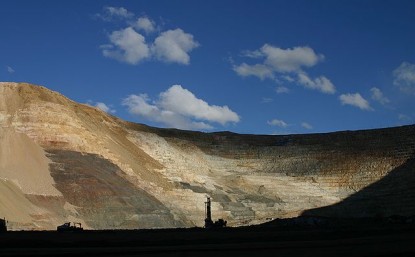
Gold and Gold stocks have rallied as expected and the consolidation in the miners in recent days looks bullish. GDX and GDXJ have digested the recent recovery quite well as Gold is testing resistance around $1200/oz. While the price action portends to more gains so does the breadth in the miners as well as short-term structure in the US$ index and bond yields.
In the first chart we plot GDX along with its advance decline (AD) line at the top. The AD line is the holy grail of breadth indicators as it is a trusty leading indicator. At the January 2016 bottom, the AD line was showing a strong positive divergence. Presently, the AD line is trading at a 3.5 month high and above its October 2016 high. If GDX were trading at the same relative level then it would be about 17% higher. Moreover, the AD line only retraced 38% of its 2016 advance while GDX retraced 62% of its advance. This suggests continued strength in the gold stocks.
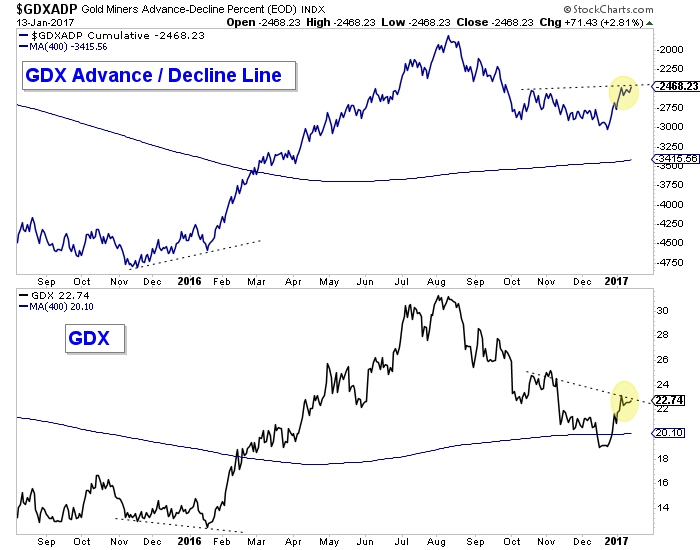
The current short-term trends in the US$ and bond yields also support more gains in the precious metals complex. The US$ index tried but failed to break 103.50 and should test at least 100. It could potentially decline to as low as 97 and test the 200 and 400-day moving averages. Meanwhile, it is no secret that bonds (like Gold) became extremely oversold (and yields extremely overbought). The 10-year yield, which closed at 2.38% should test at least 2.20% and could fall to 2.10%. Declining yields are immediately bullish for precious metals.
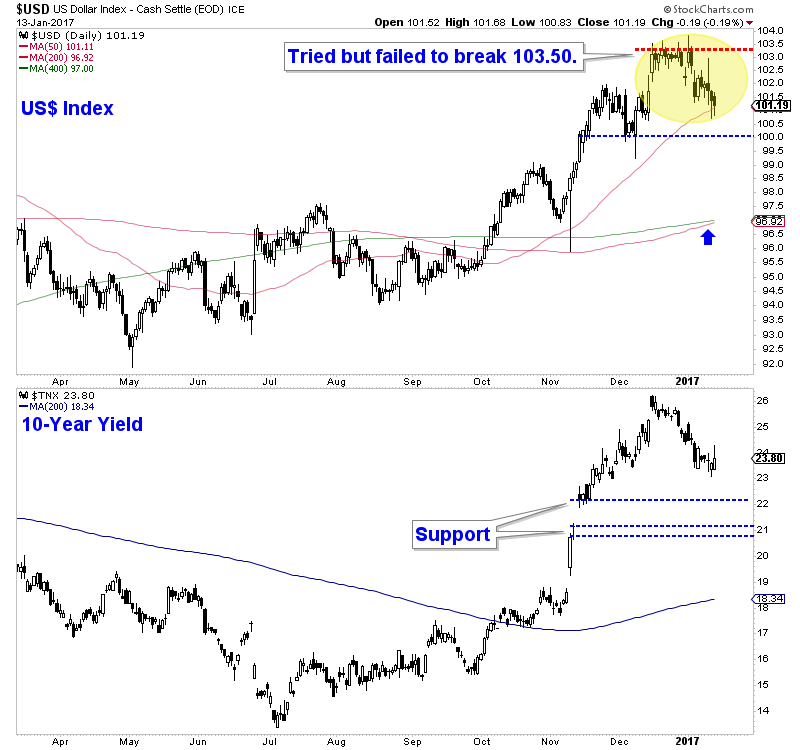
Strong breadth coupled with continued weakness in the US$ index and bond yields supports more gains in both Gold and the gold stocks. Our targets for the miners remain $25 for GDX and $40 for GDXJ. Those are the strongest and most reasonable targets but $26-$27 for GDX and $41-$42 for GDXJ are possible. Look for Gold to test $1220/oz while maximum upside on this rally is $1250/oz. We have turned more constructive on the miners but definitely expect another buying opportunity after the US$ and bond yields resume their uptrends.

Following a superb performance in 2016, the mining industry is positioned to continue enjoying the positive performance in 2017. In their January 2017 report on the global mining industry outlook, analysts from Citi projected that mining stocks will have a strong performance in 2017. This they explained will be buoyed by the trends across the industry globally whereby there is an increased free cash flow; earnings are experiencing an upward momentum and the potential to return excess capital to shareholders.
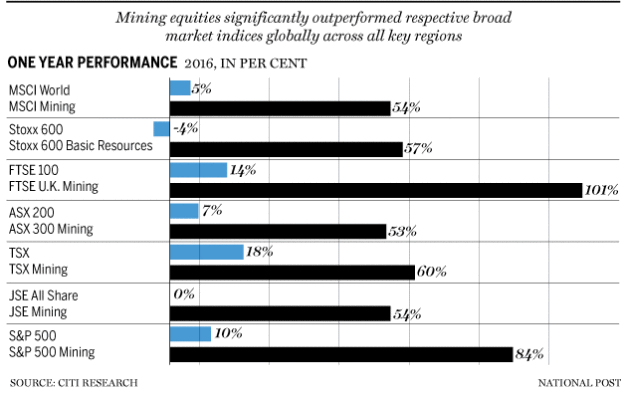
However, analysts at Stern Options in their daily market reviews noted that the odds of the mining industry outperforming other sectors within the capital markets will be minimal. “It is unlikely for the mining industry to experience the same percentage increase in stock prices as it did in 2016 due to the uncertainty surrounding global geopolitics in the wake of Brexit, the expected slow-down in China and the unknown international relations model a Trump presidency will adopt in the US,” the analysts noted.
Outside the super cycles that occurred between 2003 and 2007, the mining sector has been able to outperform the rest of the market for two or more years successfully only twice in the last 20 years. This happened for the first time in the last two decades during the tech bubble when the sector declined more than the rest of the industries in the market. The next time it happened was when the Chinese accelerated growth led to a recovery after the tech bubble burst.
2017 is expected to unfold for the mining sector in a similar manner it did in 2010 when the markets kept up with the momentum they had gained in 2009 bouncing back from the 2008 global financial crisis. Back then in 2009 the mining sector outperformed the rest of the market by 51%; in comparison last year the mining sector outperformed the market by 49%. “Mining remained the best-performing sector throughout 2016 barring a poor start to the year. The momentum slowed down during the last quarter driven by relatively poor performance in December as investors probably booked some profits,” Citi analysts wrote in their January global mining sector outlook note.
The positive momentum will be supported by several unrelated factors. On one hand, some investors will be drawn in the mining sector stocks by the fear of losing out on yet another year of outperforming the rest of the market. On the other hand, analysts believe that the bankruptcies in the mining sector globally that have been rising in the past have reached their peak and they project increase in capital expenditure and exploration activities. Mergers and acquisitions are however not expected to rally along the stock prices until the long run growth in commodity prices prove to be stable for the foreseeable future.
The clouds hanging above the projected rise in the mining sector stock prices include the depreciation of the Chinese yuan, which has not yet flown into the commodity markets and rising oil prices which will contribute to an increase in the cost of production.
In a separate research note in December 2016, Fitch Group research arm BMI also gave the global mining sector a green light for 2017. In their statement, BMI said that “We maintain a positive view toward metal prices over a 12-month horizon, boosted by improving supply and demand fundamentals, as well as rising global inflation.”
On the pessimistic perspective, BMI also identified China as a threat to rising commodity prices citing that “We expect the positive impact of stronger Chinese demand on global commodity prices to wane.” In their statement, they explained that stronger economic activity in China in 2016 and the associated commodities demand were central to the wider commodity prices re-bound experienced in the year. With the expected cool off in China and the fears about the depreciation the Chinese yuan a slowdown in the growth within the mining will probably ensue.
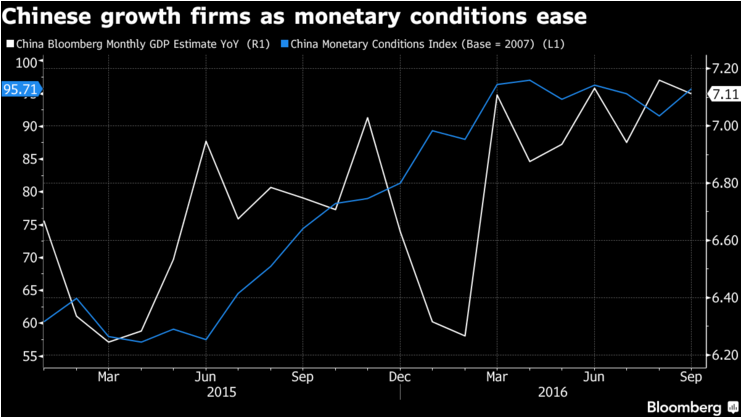
In his victory speech last year in November, US president elect promised to invest heavily in infrastructure development once he assumes office. This was a positive tide for the mining sector due to the expected high demand for metal and other commodities. However, the BMI research note released in December last year explains that the Trump effect has already been factored into the market prices and it will not have much impact when he actually starts to implement his campaign promises on infrastructure.
Despite the few lingering negative factors, the mining sector within 2017 seems to be poised for great returns just like in 2016. Investors who are yet to allocate their portfolios fully should therefore consider assigning some of their funds into the commodities sectors in 2017.

Gold has hit the ground running in this young new year, a stark contrast to its brutal post-election selloff. Rather remarkably, these strong recent gains accrued despite literally zero buying from one of gold’s most-important constituencies. The American stock investors who almost single-handedly fueled gold’s strong bull market last year are still missing in action since the election. That means big gold buying is still coming.
All free-market prices, including gold’s, ultimately result from the balance between popular supply and demand. When supply outweighs demand as evidenced by investment-capital outflows, gold is forced lower. That’s exactly what happened after Trump’s surprise win in early November. When investors flee gold for any reason, including chasing record-high stock markets, the resulting oversupply really hits prices.
When the votes started to get tallied on Election Day’s evening, Trump pulled into a surprise lead in the biggest battleground state of Florida. Gold futures rocketed higher on that, soaring 4.8% to $1337 as the early results came in! But as the plummeting stock-market futures reversed sharply the next morning, that panic gold buying was quickly unwound. That kicked off investors’ subsequent mass exodus from gold.
Over the last decade or so, gold ETFs have grown to dominate gold investment. Their soaring popularity is the direct result of their unparalleled efficiency. There is no cheaper, quicker, or easier way for stock traders to move capital into this unique asset to gain gold portfolio exposure. So gold investment has increasingly shifted from the traditional holding of physical bars and coins to owning gold-ETF shares.
The 800-pound gorilla of the gold-ETF world has always been the American GLD SPDR Gold Shares. As of the end of Q3’16, the latest data available from the World Gold Council, GLD’s commanding lead among global gold ETFs is impregnable. GLD held 948.0 metric tons of gold bullion in trust for its shareholders, or a staggering 40.6% of the total holdings of the world’s top-ten physically-backed gold ETFs!
This dominance along with GLD’s extreme transparency make it the best proxy for investment-capital flows into and out of gold. Every single trading day, GLD’s managers release the total gold bullion this ETF is holding. This is done in extraordinary detail to placate anti-gold-ETF conspiracy theorists, down to the individual-gold-bar level including serial numbers and weights. This week’s list was 1305 pages long!
The day after the election, GLD’s physical gold-bullion holdings were running 955.0 tonnes. But as the stock markets soared in the post-election Trumphoria surrounding hopes of lowering taxes and slashing regulations, investors started to flee gold. Gold is a unique asset that often moves counter to stock markets, making it an anti-stock trade. Thus gold investment demand collapses when stocks trade near record highs.
Investors simply feel no need to prudently diversify their stock-heavy portfolios with gold when the stock markets seem to do nothing but rally. So after Trump’s win, stock investors soon began to dump GLD shares at far-faster rates than gold itself was being sold. This differential selling pressure forced GLD’s managers to sell physical gold bullion to raise the necessary cash to sop up the excess GLD-share supply.
As a tracking ETF, GLD’s mission is to mirror the gold price. But GLD shares have their own supply and demand totally independent from gold’s, so GLD-share prices are always on the verge of decoupling from gold. The only way to maintain tracking is to shunt excess GLD-share supply and demand directly into physical gold itself. So GLD effectively acts as a conduit for stock-market capital to slosh into and out of gold.
Stock investors jettisoned GLD shares so fast in mid-November that this ETF’s holdings fell sharply for 11 trading days in a row. Every day GLD-share selling outpaced gold selling, so every day this ETF had to buy back the excess shares to offset that heavy differential selling. The money came from selling gold bullion, resulting in daily draws in GLD’s holdings. That short span saw GLD’s holdings plunge by 7.3% or 70.0t.
While this extreme selling moderated in December, it still continued relentlessly. Gold was driven down to $1128 the day after the Fed hiked rates for the second time in 10.5 years. While that was expected, the Fed officials’ rate-hike projections for 2017 were more hawkish than expected. That happened to mark the very bottom for gold, yet the heavy GLD selling persisted. That day GLD’s holdings were at 842.3t.
As of the Wednesday data cutoff for this essay, gold has rebounded 5.6% since then. It has rallied back up to late-November levels. A strong bounce out of extreme bearishness was inevitable, as I wrote that very week. But what’s wildly unexpected is since gold bottomed GLD’s holdings have fallen another 4.4% or 37.3t to 805.0t. GLD still hasn’t seen a single holdings build since the day after the election!
So gold somehow managed to rally sharply in recent weeks without any capital inflows from American stock investors. They not only weren’t buying GLD shares, they continued to aggressively sell them as evidenced by a couple big GLD-holdings draw days so far in January. This situation is remarkable, as it implies the investment gold buying hasn’t even started yet. That means big gold buying is still coming.
Some perspective is necessary to understand the supreme importance of GLD capital flows for gold’s performance. This first chart looks at gold and GLD’s holdings over the entire lifespan of this pioneering gold ETF. After its November 2004 birth, every subsequent year shows what happened to both its gold-bullion holdings and the gold price. Stock-market-capital flows via GLD have long dominated gold’s fortunes.
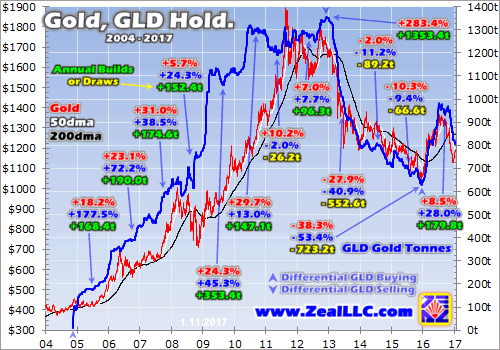
While differential GLD-share buying and selling isn’t the only force moving gold, it is certainly one of the two primary ones along with American gold-futures trading. In general gold rises and falls based on the capital inflows or outflows via GLD as evidenced by its builds and draws. Gold almost always rallies in years stock traders buy GLD shares faster than gold, and conversely falls in years where they sell GLD faster.
In 2005, 2006, 2007, 2008, 2009, and 2010 gold rallied majorly on strong GLD builds. When investors want to prudently expand their portfolio gold exposure through adding GLD shares, this ETF’s resulting physical-gold-bullion buying propels gold’s price higher. This makes sense, as the more capital bidding on any particular asset the faster its price will rise. That’s simply supply and demand in action as expected.
2011 was the lone year since GLD’s birth where the gold price disconnected from GLD’s holdings. That year gold rallied another 10.2% despite a 2.0% GLD draw. But with a mere 26.2t move, that was also the least-volatile GLD-holdings year by far. So GLD’s holdings were essentially unchanged, certainly not down materially. That relative cessation of differential GLD-share buying or selling allowed gold to decouple.
2012 again saw a solid GLD build, and gold rallied in lockstep. By that point, GLD had never suffered a sustained draw. Gold ETFs are a double-edged sword, just as easy to sell as they are to buy. In early 2013 the Fed’s radically-unprecedented new open-ended third quantitative-easing campaign started to levitate the stock markets. So gold investment demand cratered as stocks seemingly did nothing but rally.
American stock investors dumped GLD shares with a vengeance that year, resulting in an epic 40.9% or 552.6t GLD draw! That wild unparalleled flood of gold-bullion supply spewed by GLD as it sold to raise the cash to buy back the excess shares offered hammered gold 27.9% lower. That made for gold’s worst year since 1981, soon after a gold popular mania failed. That extreme gold-ETF selling kept feeding on itself.
The more stock investors dumped GLD shares, the more gold fell. The more gold fell, the more investors wanted to dump GLD shares. That ugly episode proved that gold ETFs and their easing of capital flows into and out of gold would amplify both bulls and bears. 2014 and 2015 saw gold continue to fall as the differential GLD-share selling continued. GLD’s draws those years ran 89.2t and 66.6t, key reference points.
Despite the sharp post-election selloff driven by that Trumphoria stock rally, gold still advanced 8.5% last year. On Election Day it had been up 20.3% year-to-date! 2016 proved gold’s first up year since 2012. And not coincidentally, 2016 was the first year that saw a GLD build since 2012. And that 179.8t of gold-bullion buying GLD had to do last year was actually the third-largest GLD-build year in this ETF’s history.
So realize that stock-market capital flows into and out of gold via this dominant world-leading GLD gold ETF are critical. Gold rallies when stock investors are buying GLD shares faster than gold, leading to builds as that excess buying is shunted into gold. And gold falls when GLD shares are sold faster than gold, which forces this ETF to sell bullion to buy back its own shares. Gold only makes sense with this knowledge!
Unless you understand GLD’s commanding role, you can’t understand why gold has been where it’s been or going where it’s going. This next chart zooms in to the past couple years or so, and increases the analysis resolution to quarterly. The reason gold soared in Q1 and Q2 last year is because stock-market capital was flooding into GLD. And the reason gold collapsed in Q4 is because half of that capital fled.
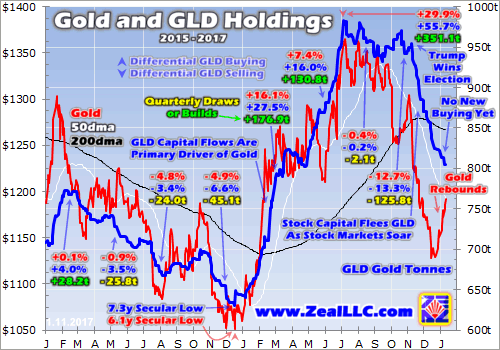
Gold’s lone up quarter in 2015 in Q1 was the result of a GLD build. The other three quarters of that year saw gold fall on increasing differential GLD-share selling. Interestingly gold bottomed the day after the Fed hiked rates for the first time in 9.5 years in December 2015, at a 6.1-year secular low. Exactly a year later last month, gold again bottomed the day after the next Fed rate hike. It’s irrational to fear Fed rate hikes!
Gold then skyrocketed 16.1% higher in Q1’16 on a monstrous 27.5% or 176.9t build in GLD’s holdings. Gold investment demand quickly shifted from deeply out of favor to back in favor for one simple reason. The lofty Fed-goosed stock markets were rolling over into a correction-grade selloff as 2016 dawned. As the anti-stock trade, gold investment demand soars when stock markets materially weaken and stoke fear.
Gold’s first new bull market since 2011 was overwhelmingly driven not just by gold ETFs, but specifically by GLD alone. According to the definitive arbiter of gold supply-and-demand measurement, the World Gold Council, total global gold demand climbed 219.4t year-over-year in Q1’16. Thus GLD’s 176.9t build accounted for a staggering 80.6% of that jump! Traditional bar-and-coin demand merely rose 0.7% YoY.
So if American stock investors hadn’t flooded back into GLD in Q1’16 as US stock markets rolled over, there never would’ve been a new gold bull! Love it or hate it, the hard reality is American stock-market capital flows into and out of gold via GLD now dominate this metal’s price behavior. That became even more apparent in Q2’16, when gold rallied another 7.4% on another huge 16.0% or 130.8t GLD build.
Per the WGC, overall global gold demand climbed 139.8t YoY that quarter. That means GLD alone was responsible for a mind-boggling 93.6% of the world total! Again bar-and-coin demand was dead flat, the whole gold story was differential GLD-share buying. Indeed in Q3 gold stalled because that differential GLD-share buying ceased. Gold drifted 0.4% lower in Q3’16 on a trivial 0.2% or 2.1t GLD draw that quarter.
So realize that pretty much everything that happened to gold last year before the election was the result of stock-market capital flowing into and out of gold via the GLD conduit. Thus it shouldn’t be a surprise that the brutal gold selloff after the election was driven by extreme differential GLD-share selling. On Election Day, GLD’s holdings were actually only just 3.4% under their bull-market high seen back in early July.
That subsequent extraordinary 11-trading-day 7.3% GLD draw was driven by US stock markets surging to new all-time record highs per the benchmark S&P 500. Stock investors were so enthralled by Trump’s promises of lower taxes and less regulation that they lapsed into euphoria. Just as in 2013 to 2015, they figured why bother owning counter-moving gold if stocks are going to do nothing but rally indefinitely?
The resulting extreme differential GLD-share selling ultimately drove a massive 13.3% or 125.8t Q4’16 draw! Those stock-capital outflows were nearly equivalent to Q2’16’s 130.8t inflows. But gold didn’t bottom at Q2 levels since futures speculators joined the stock investors in aggressively dumping gold. Q4’s enormous 125.8t GLD draw dwarfs those 89.2t and 66.6t draws seen in the full years of 2014 and 2015.
With so much capital fleeing gold, forcing GLD to spew so much gold bullion into the market to buy back its excess shares offered, it shouldn’t be surprising gold cratered to a 12.7% loss in Q4. That was one of gold’s worst quarters ever, driven by one of GLD’s biggest draw quarters ever. Gold prices are driven at the margin by investment capital flows, and there is no bigger pool of gold investment capital than GLD investors’.
Given GLD’s ironclad dominance over gold prices, the disconnect between gold and GLD holdings in recent weeks is utterly stunning. Every day the first piece of data I check is what happened in GLD’s holdings the day before. They aren’t reported until evenings well after the markets close. So ever since gold started to rally in late December, I’ve been looking for GLD builds to resume. Yet they still haven’t.
As of Wednesday, GLD had not seen a single build in 42 trading days since the day after the election! That now rivals a 42-trading-day span in mid-2013 as the longest in history without any GLD builds. If you’d told me a month ago that gold could mount a nearly-month-long 5.6% rally despite not only zero GLD builds but a cumulative 4.4% draw, I would’ve laughed. That’s wildly improbable based on modern history.
Yet here we are. Gold’s bull market of 2016 is resuming after this metal’s 17.3% plunge mostly since the election, which didn’t breach the 20% new-bear threshold. And American stock investors not only didn’t drive it, but they are actively fighting it. That means the gold investment buying hasn’t even started yet from the only group of global investors who really matter! Big gold buying is still coming via GLD shares.
American stock investors totally ignored gold in late 2015 until the US stock markets retreated decisively enough to crack the complacency bubble driven by record highs. GLD’s holdings fell to a 7.3-year secular low the day after the Fed’s first rate hike in nearly a decade in December 2015 as stock markets remained near records. It wasn’t until the stock markets started selling off that gold investment demand reignited.
Right after that December-2015 rate hike, the S&P 500 dropped 1.5% and 1.8% on back-to-back trading days. That relatively-minor selloff was enough to convince hyper-complacent stock investors that maybe owning a little gold to diversify their stock-heavy portfolios wasn’t a bad idea. January 2016 would see a lot more major S&P 500 down days with losses of 1.5%, 1.3%, 2.4%, 2.5%, 2.2%, and 1.6% as selling accelerated.
That heavy stock-market selling ultimately fueling a correction-grade 13.3% S&P 500 selloff was exactly what triggered last year’s new gold bull. And once that investment gold buying got underway, it took on a life of its own as investors love to chase winners. Even though the S&P 500 bottomed decisively for the year in mid-February, gold kept powering dramatically higher until early July on continued heavy GLD buying.
This precedent is exceedingly bullish for gold today. As I explained in depth in an essay at the very end of 2016, a major stock bear still looms. The US stock markets were radically overvalued before that crazy Trumphoria rally, which blasted them up to formal bubble valuations! Corporate earnings are simply far too low to support the high prevailing stock prices, which are purely the product of greed and euphoria.
Even if Trump proves a miracle worker, the much-anticipated lower tax rates and regulation-slashing is going to take some time to implement. I can’t imagine anything big happening on those fronts before late 2017 or early 2018 at best. In the meantime, the stock markets are long overdue for at least a 10%+ correction and more likely a 20%+ new bear. That will once again revive major gold investment demand.
If a 13% stock correction ignited a 30% gold bull in the first half of 2016, imagine what a real bear would do for gold prices. American stock investors are radically underinvested in gold today, with essentially zero portfolio exposure. So as stocks inevitably sell off as the impossible Trumphoria expectations inevitably lead to deep disappointment, there is vast room for American stock investors to diversify back into gold.
While gold has indeed looked impressive in recent weeks, we haven’t seen anything yet compared to what will happen when differential GLD-share buying explodes again. Gold’s upside in early 2017 truly has the potential to even exceed early 2016’s strong gains! The stock markets are far more precarious now than a year ago, and the more downside they suffer the more investors will shift capital back into gold.
This coming major new upleg in this young gold bull can certainly be played with GLD or call options on it. But the gains in the gold miners’ stocks will dwarf the gains in gold, since their profits growth greatly leverages gold’s upside. As I discussed in depth last week, we are already seeing that. Over that recent less-than-a-month span where gold rallied 5.6%, the leading gold-stock index already surged 21.0% higher!
The bottom line is big gold buying is still coming. American stock investors, the driving force behind all of gold’s major moves for years, haven’t even started returning to gold yet. The leading GLD gold ETF hasn’t seen a single build since the day after the election, and has continued to suffer major draws in early 2017. Gold’s sharp rebound out of its post-election lows despite a GLD-selling headwind is remarkable.
Just as a year ago, all it will take to rekindle gold demand from American stock investors is a correction-grade stock-market selloff. And one is way overdue and increasingly likely thanks to all the extreme distortions of valuations and sentiment the Trumphoria rally spawned. As stock complacency cracks, American stock investors will rush back to gold to diversify their portfolios and thus catapult it much higher.
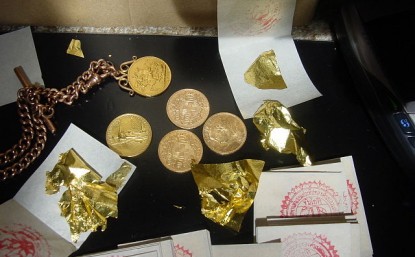
1. The last two bear markets in US stocks were deflation-oriented.
2. The next one is likely to be inflation-themed, and could feature the US dollar and gold soaring higher at the same time.
3. Please click here now. Chinese producer price inflation is suddenly growing at the fastest pace in five years, and it will soon be exported to America.
4. Please click here now. Double-click to enlarge.
5. Gold has been rallying since mid December. It may be poised to breakout to the upside from the $1170 – $1185 trading range and rise to $1200.
6. Please click here now. Hedge funds are holding a lot of short positions in gold on the COMEX.
7. That’s quite positive for the price, because most of these funds use a tremendous amount of leverage. That means they have a hard time holding onto their positions when they get margin calls.
8. It appears that many of these funds have added to their short positions into the current gold price rally, and that means a lot of their holdings are at or close to the margin call threshold.
9. Regardless, it’s important that gold investors focus where the price is now, rather than just on where it might be going in the future.
10. Here’s why: Just like plants in a garden, gold stocks and bullion need to be “planted and pruned”.
11. Gold has rallied about $60 from the $1125 area lows, and investors need to trim holdings into this strength.
12. For all practical wealth building intents and purposes, it’s not that important whether gold rises or falls from here, but it’s very important to trim more positions if it continues to rise, and be a buyer if it declines.
13. Please click here now. Double-click to enlarge. GDX bulls and bears are battling in the $22.50 resistance zone.
14. Gold bugs should cheer that GDX rises out of the pennant formation and rises to the next resistance zone at $25, but investors should sell lightly into that rally if it happens.
15. Note the 14,7,7 Stochastics oscillator at the bottom of that 8 hour bars chart. It’s suggesting that the pennant could fail, and GDX could may not make it to $25 on this rally.
16. The bottom line: Gold stock enthusiasts should be sellers here in the $22.50 area, sellers of more in the $25 area, and eager buyers in the $20 and $18 price zones!
17. I get a lot of emails about the gold demand situation in India. There’s no question that Indian government policies have had a negative effect on gold demand there in 2016. What happens in 2017 will likely be determined in the February budget.
18. If the import duty is reduced, Indians will be more willing to buy gold in the cashless manner being promoted by the government.
19. Regardless, the big picture for gold in 2017 is likely to centre more on events in America than India. The movement of money out of the US central bank and into bank accounts is underway, and rate hikes will accelerate it.
20. Money velocity is poised to reverse, perhaps by mid 2017, and at the same time the bull market in US stocks is very long in the tooth.
21. Gold rallied nicely after the Fed’s first rate hike in 2015, and it’s rallying nicely again after the second rate hike.
22. Investors have nothing to fear from rate hikes, and it is those hikes that will incentivize banks to move more money out of the Fed and into the fractional reserve banking system.
23. Bank loans made at the end of the business cycle tend to be much more inflationary than loans made in the early stages. I expect 2017 will see more bank loan growth against the background of higher nominal rates and lower real (nominal minus inflation) rates. This is very positive for precious metals.
24. Please click here now. Double-click to enlarge. Silver price enthusiasts may be a bit disappointed with the price action during this rally, but it’s important to remember that silver typically lags gold at the start of a major move, and leads it in the later stages. By the end of 2017, as inflation fears begin to take hold, silver should be leading gold by a significant margin!
Stewart Thomson of Graceland Updates, Guest Contributor to MiningFeeds.com

Although we expected a rally in the gold mining sector, we have been surprised by its strength and recent buying pressure. From the lowest ticks, Gold has rallied less than 6% but GDX has gained 25% and GDXJ has soared 36%. This rebound adds to the evidence that the gold stocks are leading the metal. That being said, the gold stocks are approaching some strong resistance levels which coincide with Trump’s election victory.
Below we plot the weekly line charts of GDXJ (top), GDX and Gold (middle). The weekly closing price is each data point. Note how both GDXJ and GDX (other than for one week) held their 62% retracement and 80-week moving averages while Gold did not. On the monthly charts (not shown) we find that the miners tested but closed above their 20-month moving averages (in November and December) while Gold closed below its 20-month moving average at the end of both months. Furthermore, note that Gold is some $50/oz below its Q1 2016 levels yet both GDX and GDXJ are trading considerably above those levels.
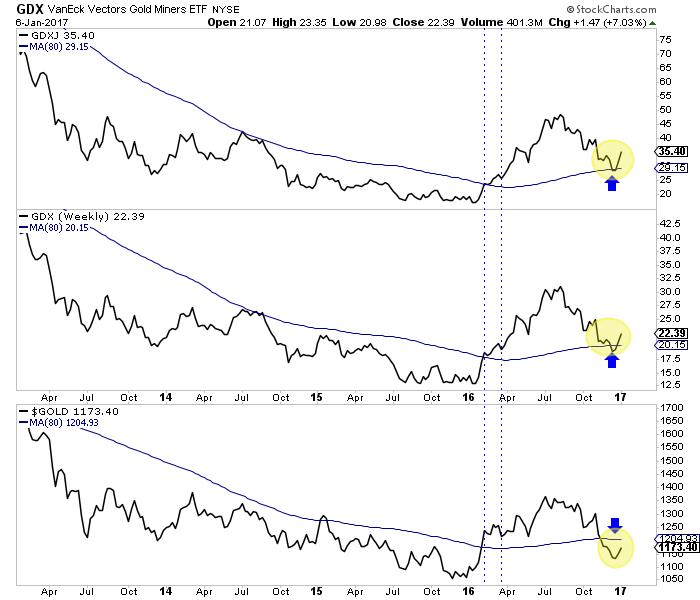
While the gold stocks are showing good progress and have more immediate upside potential, they are approaching strong resistance. The daily candle charts below detail the resistance in GDXJ (at $40-$41) and in GDX (at $25-$25.50). Note the strong selling (thick black candles) immediately prior to and after the election. Also, with respect to GDX, the more widely followed and traded ETF, the 200-day moving average comes into play near $25 and the 50% retracement is at $25.15. You think GDX’s advance might stop at $25?
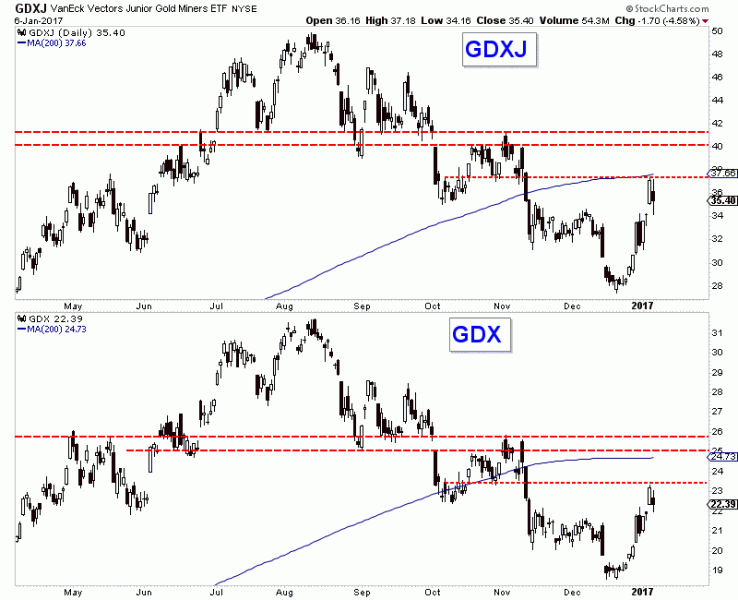
We expect the miners will reach these upside targets soon but a correction will follow, which will inform us quite a bit as to how sustainable this rebound is. If Gold is going to rollover again then the miners could end up retesting their December lows. However, if bonds continue to rally and real yields decline then this rebound could push beyond the Trump resistance levels. We bought a few positions recently but are holding some cash as we suspect there will be more buying opportunities before the gold stocks really takeoff.
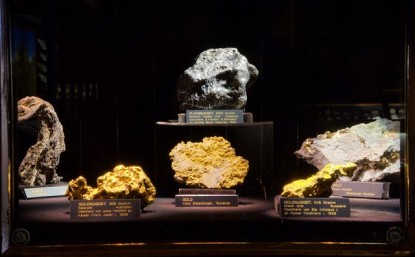
The gold miners’ stocks are rocketing higher again after suffering a rough few months. Following sharp selloffs on gold-futures stops being run, the Trumphoria stock-market surge, and a more-hawkish-than-expected Fed, this battered sector had largely been left for dead. But gold stocks’ strong fundamentals finally overcame the dismal herd sentiment last week, paving the way for this sector to shine again in 2017.
This “shine again” assertion likely seems dubious to casual observers, since the gold miners’ stocks suffered a miserable Q4’16. The leading HUI NYSE Arca Gold BUGS Index plunged 21.1% in a quarter where the benchmark S&P 500 broad-market stock index surged 3.3%. Naturally gold miners’ profits are fully dependent on gold prices, and this metal fell 12.7% in Q4 which proved one of its worst quarters ever.
Thus no sector has been more out of favor in recent months than precious metals. Gold and therefore gold-stock bearishness abounded, with bullish outlooks dwindling near nonexistent. But viewing gold stocks solely through the extremely-distorted post-election lens is a serious mistake. Despite their sharp Q4 selloffs, this sector as measured by the HUI led the markets by still soaring 64.0% higher in full-year 2016!
If any other sector like technology or financials or even energy had seen such dominating performance last year, the financial media would be endlessly extolling it. But not gold, it’s just too contrarian. 2016 was a solid year for gold, with its 8.5% rally nearly catching the S&P 500’s 9.5%. As of Election Day, gold was still up 20.3% year-to-date which trounced the 4.7% of the S&P 500. Gold really did shine last year!
The highlight of gold’s first up year since 2012 was certainly the first half. Between a 6.1-year secular low in mid-December 2015 on highly-irrational Fed-rate-hike fears and early July, gold powered 29.9% higher in its first bull market since 2011. And over roughly that same 6.5-month span, that leading HUI gold-stock index soared 182.2% higher! Gold stocks’ stellar performances dominated the markets last year.
Nearly a year ago as the HUI fell to miserable 13.5-year secular lows, I advised that a major new gold-stock bull was imminent. Last January’s gold-stock prices were fundamentally absurd relative to this sector’s underlying earnings power even at then-prevailing gold prices. A similar extreme sentiment-distorted pricing anomaly just happened last month. So 2017’s gold-stock setup is just as bullish as 2016’s proved!
Sadly most traders succumbed to the recent groupthink bearishness to foolishly bury their heads in the sand regarding gold stocks. The same thing happened a year ago. Speculators and investors alike are always ignoring the most-beaten-down sectors which usually have the greatest upside potential. So it’s incredibly important to get up to speed on gold stocks as 2017 dawns, before they are bid far higher again!
Maintaining perspective is the key to overcoming the dangerous herd emotions of greed and fear. They convince traders to wrongly buy high and sell low, ultimately leading to catastrophic losses. But armed with the big picture, it is much harder to fall into the trap of extrapolating recent performance out into the indefinite future. This first chart looks at the gold-stock bull over the past year rendered in HUI terms.
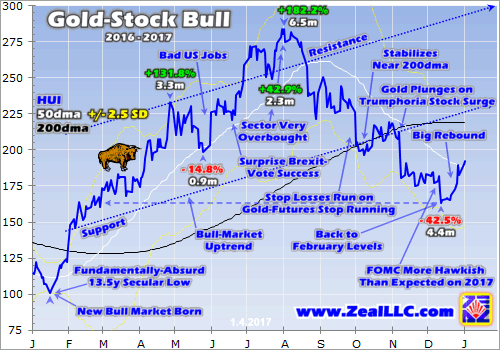
After nearly tripling in just over a half-year by early August, the red-hot gold stocks were indeed due for a serious correction as I warned in July. Infected with rampant greed and wildly overbought, this sector soon sold off hard in August. Sharp corrections in bull markets are totally normal and very healthy, as they bleed away excessive greed to keep sentiment balanced. After that gold stocks stabilized in September.
But as October dawned, an anomalous adverse event slammed them out of the blue. The gold-futures speculators who dominate short-term gold trading must deploy stop losses to protect themselves from these hyper-leveraged trades. They had a big mass of stops set near $1300, which had proven strong support for gold since it soared in late June on that Brexit-vote surprise. That was a logical level to protect capital.
After drifting lower in late September, gold finally slipped into that futures-stop-infested zone around $1300 in early October. The consequential stops triggering soon cascaded, and gold’s sharp selloff became self-feeding. The resulting mass stopping quickly spilled into gold stocks, causing the HUI to plummet 10.1% on October 4th! While painful, that surprise event was an extreme anomaly that wasn’t sustainable.
Indeed gold stocks soon stabilized again, with buyers returning near their key 200-day moving average and parallel bull-market-uptrend support in October. Gold and its miners stocks climbed on balance right into election night, when they soared in futures and overseas trading as Trump took the lead in Florida. All pre-election market behavior strongly suggested gold would surge if Trump somehow managed to win.
American gold futures blasted 4.8% higher from that afternoon’s close on election night, hitting $1337. And over in Australia gold stocks were soaring 15%+! But later that very night as Clinton conceded to virtually eliminate the risk of a contested election, the US stock markets started to rally sharply out of limit-down 5% S&P-500-futures losses. And as the anti-stock trade, gold was hammered on that stunning reversal.
Gold is a unique asset that moves counter to the stock markets, making it essential for diversifying stock-heavy portfolios. Gold investment demand naturally surges when stock markets weaken, as gold’s gains help to offset stock losses. But when stock markets seemingly do nothing but rally indefinitely, investors soon forget about prudently diversifying portfolios. So sharp stock rallies temporarily kill gold demand.
As gold dropped in the days after the election surprise on the Trumphoria stock-market rally, the gold stocks were blitzed again with another mass stopping. On November 10th and 11th, the HUI plummeted 7.8% and 8.0%! These horrific losses were the final straw for most gold-stock investors, destroying their will to remain in such a volatile sector. So gold stocks went from loved in mid-2016 to despised in mid-November.
But again perspective is crucial. How often does a radical outsider like Trump run for and actually win the US presidency? Nothing like that has ever happened before. Any market selloff driven by an extreme anomaly is never sustainable. Gold stocks didn’t plunge because their fundamentals were failing, but because an epic surprise post-election stock-market rally seduced investors out of gold back into lofty stocks.
Again since that extreme gold-stock selloff was purely sentimental and had nothing to do with the hard fundamental realities of the gold-mining industry, these battered stocks quickly stabilized. Despite the stock-market euphoria and resulting gold antipathy, the HUI ground sideways for an entire month from mid-November to mid-December. The unjustified extreme gold-stock selling had largely exhausted itself.
But on December 14th, the Fed surprised on the hawkish side so gold and gold stocks took another hit. While traders had universally expected the Fed to hike rates for the second time in 10.5 years, they did not expect elite Fed officials to forecast three more rate hikes in 2017 instead of two previously. So yet again gold stocks were crushed in emotional fear-drenched selling, ultimately pummeling the HUI to 163.5.
Those were essentially February levels, last seen on the first trading day of March. While that post-Fed selloff wasn’t an extreme anomaly like the early-October and post-election ones, it was devastating to already-tattered gold-stock psychology. An astonishing 2/3rds of gold stocks’ bull market in the first half of 2016 had been erased! The gold miners were universally hated, the pariahs of the investment world.
But that didn’t make any sense at all. As of its very closing low the day after last month’s Fed decision, the gold stocks as measured by the HUI were still up a fantastic 47.0% year-to-date! That compares to just 10.7% for the S&P 500, and this sector likely remained the top performer in 2016. In any other sector in all the stock markets, traders would be salivating at buying the dip after such a supremely-anomalous selloff.
Instead of fretting about a 42.5% drop over 4.4 months largely driven by two unrepeatable events, traders should’ve been remembering gold stocks’ powerful first-half gains. Back in July and August when the gold stocks were high, investors and speculators alike were falling all over themselves to deploy capital to chase gains. But they were nowhere to be found when these miners’ stocks plunged to fire-sale prices.
I can’t help but marvel at this glaring disconnect. I’ve spent decades actively speculating in the stock markets, and have shared our contrarian research via my financial-newsletter business for 17 years now. The most-shocking revelation I’ve learned is how susceptible to groupthink psychology the vast majority of investors and speculators are. They love to buy high when greed reigns, but refuse to buy low as fear mounts!
Last summer traders were eagerly rushing to buy gold stocks high, to chase the strong gold-stock gains. Yet just a few months later when these very-same elite gold miners were deeply on sale for 40%+ off, these same traders who loved them last summer wanted nothing to do with them. What is so hard to understand about buying low and selling high? Buying low means embracing fear when few others will buy.
Fully wrapped up in popular bearish sentiment, traders totally lost sight of the gold-stock fundamentals in much of November and December. I did my best to help them overcome that, spending long weeks in late November and early December digging deeply into hard gold-mining fundamental data from these companies’ just-published third-quarter financial reports. Yet that super-important research fell on deaf ears.
I dug deeply into the top 34 component companies of each of the dominant gold-stock ETFs, the GDX VanEck Vectors Gold Miners ETF and the GDXJ VanEck Vectors Junior Gold Miners ETF. It turned out in Q3’16 these elite GDX major gold miners reported average all-in sustaining costs of $855 per ounce. And the elite GDXJ junior gold miners weren’t much worse at $911 per ounce. These numbers are crucial.
All-in sustaining costs reveal what it costs the gold miners, individually or as an industry, to maintain and replenish their current operations. Between Election Day and year-end, the gold price averaged $1177 per ounce. Extending to all of the dismal Q4’16, that climbed to $1218. And even at worst after the Fed decision, gold only briefly fell to $1128. None of these gold levels were remotely close to threatening $855!
Even on gold’s worst day in Q4, the elite gold miners of GDX were still earning big profits of $273 per ounce. That equates to an amazing 24% profit margin that most industries would sell their souls for. At the Q4 average gold price, these earnings were fully a third higher at $363 per ounce! Yet the irrational fear was so great that gold stocks were battered back to prices first seen in July 2003 when gold traded near $360.
Stop and think about that for a second. Just a couple weeks ago, in a quarter where the gold miners likely earned $363 per ounce mined after all expenses, their stock prices were trading at levels first seen 13.4 years earlier when the entire gold price was less than current profits! The only words that come to mind to describe this are ridiculous, ludicrous, and absurd. The recent gold-stock prices weren’t righteous.
For 7 weeks in a row I wrote comprehensive essays explaining this extreme gold-stock anomaly, and thus what radical upside the gold stocks had. As always I put my money where my mouth was, buying and recommending 8 new specific gold-stock and silver-stock trades on December 20th and 4 more on December 27th to the subscribers of our weekly Zeal Speculator newsletter. We also added new call options.
On December 31st I extended the buy recommendations to our monthly Zeal Intelligence newsletter with 5 new gold-stock and silver-stock trades. The incredible opportunities in these beaten-down gold stocks trading at fundamentally-absurd prices were explained in depth in real-time to our subscribers as they happened. Prudent contrarian traders who listened instead of ostriching are now making out like bandits.
Being so close to year-end, I didn’t expect the new investment buying to flood into gold stocks until the new year. But it’s always important to get deployed before everyone else catches on, as that’s when the buy-low opportunities are the greatest. And out of the blue on no news, gold stocks started rallying on the day before the long Christmas weekend. That strong contrarian buying persisted for most of last week.
And as 2017 dawned this week, investors immediately started looking for deeply-undervalued sectors to position in for this new year. And the still-beaten-down but-quickly-recovering gold stocks won a sizable portion of those capital inflows despite their tough fourth quarter. As of the middle of this week, in less than 3 weeks since its extreme post-Fed low the HUI has already catapulted an amazing 17.6% higher!
As always the stocks of the smaller gold and silver miners with superior fundamentals we specialize in enjoyed gains amplifying those seen in the major miners dominating the HUI and GDX. And despite the sharp rebound gold stocks have seen in recent weeks, they are just getting started. Odds are this sector will once again prove one of if not the best-performing sector in all of 2017, building on 2016’s strong gains.
As of the Wednesday data cutoff for this essay, the HUI was still only trading at 192.3. That merely took it back to levels seen in the immediate post-election plunge. The gold stocks still remain well below their strong 200dma and bull-market-uptrend support zones, and 32.3% under their early-August bull-market high per the HUI. The gold stocks’ upside potential from here remains vast, as evidenced on all fronts.
In addition to battered technicals, gold-stock sentiment was crushed to hyper-bearish levels late last year. It will take a long time and a lot of rallying to eradicate that excessive fear and restore sentiment balance to this sector. And fundamentally, gold stocks remain wildly undervalued relative to the profits they can spin off at prevailing gold prices. A quick proxy for that is the HUI/Gold Ratio, rendered here.
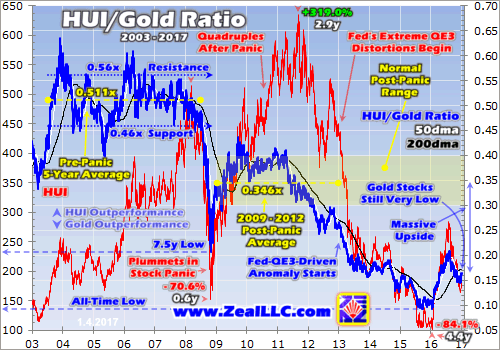
I’ve often discussed this chart extensively in the past, including nearly a year ago when calling a new gold-stock bull the very week 13.5-year HUI lows were witnessed. In a nutshell, the HUI/Gold Ratio distills the key fundamental relationship between gold prices, gold-mining profits, and therefore gold-stock price levels into a single line. Gold-stock prices tend to trade in a range relative to underlying gold levels.
On the day after the Fed’s hawkish surprise last month, the HGR fell to 0.145x. In other words, the HUI closed at 14.5% of gold’s close. Outside of the extreme record HGR anomalies seen in the last half of 2015, that was among the lowest HGR levels ever. Back in mid-January 2016, the HGR briefly fell to an all-time low of 0.093x. But such crazy lows are unsustainable sentiment-driven anomalies, temporary distortions.
As of the middle of this week, the HGR has still only recovered to 0.165x. From 2009 to 2012, which were the last normal years between 2008’s stock panic and 2013 when the Fed’s radical QE3 started to levitate the stock markets and crush gold, the HGR averaged 0.346x. So merely to mean revert back up to normal levels relative to today’s prevailing gold prices, the HUI still needs to rally another 109% from here!
But that’s far too conservative for a couple major reasons. All mean reversions out of extremes tend to overshoot proportionally in the opposite direction. So the abnormally-low HGR levels in recent years driven by extreme fear will almost certainly yield to abnormally-high levels in coming years fueled by excessive greed. A proportional overshoot yields a topping HGR target of 0.599x, for another 262% HUI rally.
And gold itself isn’t going to remain at the artificially-depressed low levels seen since the election. Gold-futures speculators will return with a vengeance as the wildly-overcrowded long-US-dollar trade reverses dramatically in 2017. And gold investors will flock back as the bubble-valued US stock markets inevitably roll over into their long-overdue bear. Thus gold is looking at 2017 gains far better than those seen last year.
As gold mean reverts higher, gold-mining profits greatly leverage and amplify its gains. Gold-mining costs are largely fixed when mines are planned. That’s when engineers decide which ore bodies to mine, how to dig to them, and how to process that ore. This determines how much capital investment is necessary to bring mines online, huge fixed costs. After that, variable operating costs don’t fluctuate too much.
Plugging higher gold prices into any HGR target, either an unlikely strict mean reversion or a very-likely proportional overshoot, yields commensurately higher gold-stock price targets. The math is simple. Take any gold level you find likely in the coming years, multiply it by 0.346x or 0.599x, and you get the HUI levels that can support. The battered gold stocks are likely only just starting a mighty new multi-year bull market!
You can certainly ride the coming massive gold-stock gains in those leading GDX and GDXJ gold-stock ETFs. But at best they will mirror sector gains, as they are over-diversified and held back by too many underperforming gold stocks with inferior fundamentals. A carefully-handpicked portfolio of elite gold and silver miners with superior fundamentals will see gains dwarfing those of the gold-stock ETFs and indexes.
The bottom line is gold stocks are really set to shine in 2017, as early trading is already proving. This sector was just battered to fundamentally-absurd price levels in the wake of the election surprise. With gold-mining earnings remaining strong, the recent gold-stock lows were fully driven by extreme bearish sentiment. Such fear anomalies never last, always paving the way for massive mean reversions higher.
The latest one has already started, and gold stocks still have easy potential to at least double from here even at low prevailing gold prices. But as the overbought stock markets and US dollar inevitably reverse lower this year, gold’s own bull will resume. Higher gold prices will greatly increase the profitability of gold mining, and fuel a major new multi-year gold-stock bull. As always the early investors will earn fortunes.

Way before the elections day commodity prices were already volatile as expected due to the uncertainty of the US presidential elections on November 8th 2016. However, after the shocking victory by president-elect Donald Trump, investors now know their fate is determined and markets are trying to figure out what impact Trump’s presidency might have on the economy in the long run. Once the full risk exposure and the potential benefits of Trump’s presidency are determined, markets will then start factoring them in the commodity and other financial assets’ pricing both in the US and globally.
Economic analysts have not been able to fully predict the economic policy changes that Trump will implement when he assumes office in January 20th 2017. But based on his campaign promises, a lot of the internal trade policies and international trade agreements the US has will be affected in one way or the other. This is then expected to create an inflationary pressure within the economy; which will keep real interest rates low and boost commodity trading since bond holders will opt to allocate some of their portfolios to commodities in a period of low interest rates. The expected trends in gold and copper prices will however follow different paths and will be supported by different aspects of Trump’s proposed economic policies.
Gold
Gold has been known to be the safe haven for investors over the years when there is significant market uncertainty. Starting June 2016 the election fever in the US picked up and polls began showing that the race between Trump and Hillary was getting tight, gold trading started rising. The trend was not however a smooth one with a lot of fluctuations experienced all through until October when Trump’s publicity went down low and the race was starting to be more predictable. As we neared the homestretch in November, Trump managed to recover in publicity and popularity; making the race tighter and resulting to another spike in gold prices. The upward trend then continued until the Election Day after which the gold price dipped and has been on a downward trend since to date.

With Trump having recorded a clear win, markets are now not in a hurry to make guesses on the next move until he is sworn in and assumes office in January 2017. In the mean-time, most investors are on a hold mode with a wait-and-see strategy before making their next investment moves; hence explaining why the gold prices are not rising as expected. However, if Trump implements policies such as reversing NAFTA and imposing hefty tariffs on China as he promised during his campaigns, then the inflationary pressure will kick in in the US. This will then be followed by lower real interest rates which encourage more borrowing from by investors in order to invest in higher assets such as gold and other commodities that will be offering higher returns. Gold price is therefore expected to remain low until next year when it will pick up an upward trajectory as new policies start being implemented; and rise to an expected high of $1,300 an ounce.
Copper
President-elect Donald Trump in his victory speech promised that he would prioritize infrastructure development once he assumes office officially. This was welcome news for the construction industry with the promised construction of schools, hospitals and roads. Construction and engineering companies saw their shares soar up immediately after the victory speech and some stocks such as Granite Construction Inc. and AECOM have gained more than 20% since November 8th. Apart from the benefits of potentially getting the massive deals to implement the stimulus package on infrastructure development, these companies stand to gain from the expected cuts in domestic corporate taxes. With most of them being located in the US, a strong dollar will not have an impact on their bottom lines.
This optimist and the expected high government expenditure on infrastructure have seen copper prices rise steadily since the Election Day to date. Much as the trend is expected to reach a resistance level and plateau at some point, the current upward trend is expected to be sustained until the end of the first quarter in 2017. Copper futures are aligned with the market expectations so far; having shot up by about 24% from November 8th to date as shown below.

A Trump presidency seems to be good news to commodity traders at least in the short-run. However, as Trump starts implementing some of his proposed policy changes and amend others before implementing them, the market sentiments might shift towards the stock and bond markets. But in the mean-time commodities are more favored by investors and their prices are expected to keep rising all through the first quarter of 2017.
If you would like to receive our free newsletter via email, simply enter your email address below & click subscribe.
CONNECT WITH US
Tweets
Tweet with hash tag #miningfeeds or @miningfeeds and your tweets will be displayed across this site.
MOST ACTIVE MINING STOCKS
Daily Gainers
 Lincoln Minerals Limited Lincoln Minerals Limited |
LML.AX | +125.00% |
      |
GCR.AX | +33.33% |
      |
CASA.V | +30.00% |
      |
AHN.AX | +22.22% |
      |
ADD.AX | +22.22% |
      |
AZM.V | +21.98% |
      |
NSE.V | +21.05% |
      |
DYG.V | +18.42% |
      |
AAZ.V | +18.18% |
      |
GLA.AX | +17.65% |

 Follow us on Twitter
Follow us on Twitter Become our facebook fan
Become our facebook fan








